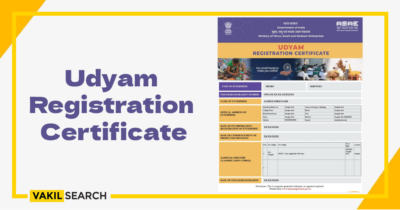The Atmanirbhar Bharat package, on May 13, 2020, triggered a redefinition of MSME, enacted by the Ministry on June 1st, with changes effective from July 1st.
On 13th May 2020, the Atmanirbhar Bharat package announced a revision in the definition of Micro Small and Medium Enterprises (MSME). Following the package report, several requests for an upward revision of the MSME definition were submitted.
Taking these representations into consideration, the Ministry of Micro, Small, and Medium Enterprises, through its gazette notification dated 1st June 2020, officially declared the upward revision of the MSME definition and criteria. The new definition and criteria for MSME will take effect from 1st July 2020, while the existing MSME definition will remain valid until 30th June 2020.
What is MSME?
- MSME stands for Micro, Small, and Medium Enterprises.
- It’s a classification for businesses based on their size and investment, used for policy support and benefits.
- In India, MSMEs play a crucial role in economic growth, employment generation, and innovation.
New Guidelines for MSME in 2023
- Updated Criteria:
- Investment in plant and machinery/equipment up to Rs. 50 crore (increased from Rs. 25 crore)
- Annual turnover up to Rs. 250 crore (increased from Rs. 100 crore)
- Additional Measures:
- Enhanced credit guarantee coverage for MSMEs
- Streamlined credit facilities and loan processes
- Focused initiatives for technology adoption and upgradation
- Special support for women-led and rural MSMEs
What Are the Reasons for Revised Criteria of MSME?
- Accommodate Growth: Allow enterprises to expand without losing benefits.
- Address Inflation: Adjust for rising costs and maintain relevance.
- Incentivize Exports: Promote global competitiveness by excluding exports from turnover calculation.
- Simplify Compliance: Unify criteria for manufacturing and service enterprises, reducing administrative burdens.
- Enhance Competitiveness: Strengthen MSMEs’ resilience and position in the market.
- Encourage Formalization: Bring more enterprises under the MSME umbrella, expanding access to support and formalization benefits.
- Foster Inclusive Growth: Promote wider participation in the economy, especially from women entrepreneurs and rural enterprises.
Revised MSME definition – The Atma Nirbhar Bharat package
In the Atmanirbhar Bharat package on 13.05.2020, a revision to the MSME definition was announced, 14 years after the MSME Development Act. This aims to broaden the scope of schemes by introducing composite criteria of investment and turnover. The distinction between the service and manufacturing sectors has been eliminated.
Effective Date: July 1, 2020
Basis for Classification: Investment in plant, machinery, or equipment (excluding land and building) and annual turnover.
| Category | Investment in Plant, Machinery, or Equipment | Annual Turnover |
| Micro Enterprise | Not exceeding ₹1 crore | Not exceeding ₹5 crore |
| Small Enterprise | Not exceeding ₹10 crore | Not exceeding ₹50 crore |
| Medium Enterprise | Not exceeding ₹50 crore | Not exceeding ₹250 crore |
Non-Tax Benefits for Three Years Post-Reclassification
- Continuation of benefits: Enterprises that reclassified into a higher category due to the revised definition can continue to avail of benefits under their previous category for three years.
- Benefits include:
- Priority sector lending
- Government procurement concessions
- Technology and skill development support
- Market access initiatives
The Old Definition of MSME – MSMED Act, 2006
The Ministry of Micro, Small, and Medium Enterprises derives its existing definition criterion from the Micro, Small, and Medium Enterprises Development (MSMED) Act, enacted in 2006. This act classifies MSMEs based on the investment in plant and machinery, with distinctions for manufacturing and services units. Following the enactment of the MSMED Act in 2006, it categorizes Micro, Small, and Medium Enterprises (MSMEs) into two types:
- Manufacturing enterprises: Engaged in the manufacturing or production of goods.
- Service enterprises: Involved in providing or rendering services.
| Sl.No | Type of Enterprises | Manufacturing enterprises (Investment) | Service enterprises (Investment) |
| 1 | Micro enterprises | ≤ ₹25 Lakhs | ≤ ₹10 Lakhs |
| 2 | Small enterprises | ₹25 lakhs to ₹5 Crore | ₹10 lakhs to ₹2 Crore |
| 3 | Medium enterprises | ₹5 Crore to ₹10 Crore | ₹2 Crore to ₹5 Crore |
Recent Updates on MSME Guidelines:
- Clarification on investment calculation: Includes all equipment except land and building, regardless of ownership or lease.
- Enhanced focus on innovation and technology adoption: New schemes and incentives to promote innovation and technology adoption among MSMEs.
- Streamlined registration and compliance processes: Simplified procedures for Udyam registration and other compliances.
- Strengthened support for rural enterprises and women entrepreneurs: Special schemes and initiatives to promote entrepreneurship in rural areas and among women. Know more about MSME Registration Process in India!
Conclusion:
The revised MSME definition and recent updates reflect the government’s commitment to supporting the growth and development of MSMEs. The expanded scope, continued benefits, and policy initiatives are expected to create a more conducive ecosystem for MSMEs to thrive and contribute significantly to the Indian economy.
FAQs
How does the turnover and investment limit vary for micro, small, and medium enterprises under the updated criteria?
Under the revised definition (effective July 1, 2020), MSME classification depends on both investment in plant, machinery, or equipment (excluding land and building) and annual turnover: Category Investment in Plant, Machinery, or Equipment Annual Turnover Micro Enterprise Not exceeding ₹1 crore Not exceeding ₹5 crore Small Enterprise Not exceeding ₹10 crore Not exceeding ₹50 crore Medium Enterprise Not exceeding ₹50 crore Not exceeding ₹250 crore
Are there any specific benefits or incentives associated with the revised MSME classification?
Yes, several benefits are available to MSMEs based on their classification: Priority sector lending: Easier access to loans at lower interest rates. Government procurement concessions: Reservation of certain contracts for MSMEs. Technology and skill development support: Government-funded programs and subsidies. Market access initiatives: Assistance in participating in trade fairs and exhibitions.
What is the process for an existing MSME to transition to the new classification under the revised criteria?
Existing MSMEs are automatically reclassified based on their latest financial statements. No further action is required unless they want to avail of benefits of the new category, which might involve updating their Udyam registration.
How does the revised MSME classification impact loan eligibility and interest rates for businesses?
Depending on your new classification, banks might consider you a less risky borrower, potentially leading to easier loan approvals and lower interest rates. However, this also depends on your individual business financials and creditworthiness.
Are there any obligations for MSMEs in terms of reporting or documentation under the new criteria?
Reporting requirements might vary depending on your classification and business activities. Generally, you'll need to file annual returns and maintain financial records as per relevant regulations.
Where can businesses find official information and guidance on the revised MSME criteria to ensure compliance?
You can find official information and guidance on the revised MSME criteria on the website of the Ministry of Micro, Small & Medium Enterprises (MSME): https://msme.gov.in/
Read more:-










